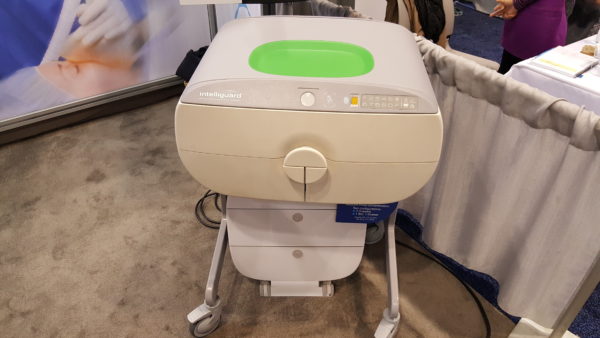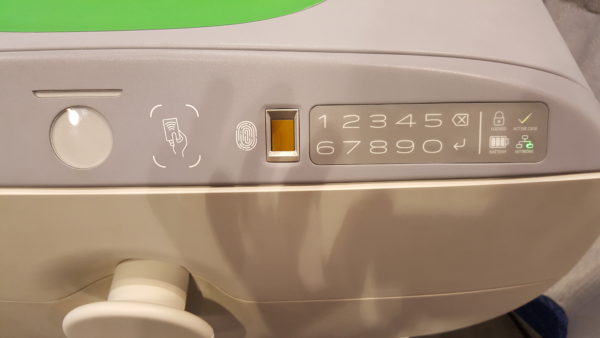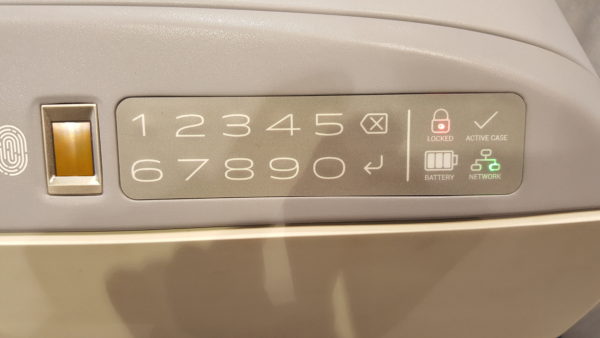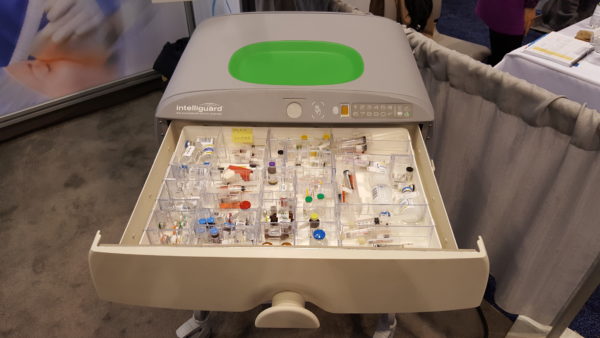The Intelliguard® Linked Visibility Inventory System™, or LVIS for short, is an RFID-enabled anesthesia cart designed for use by anesthesiology providers in the OR. I spoke about this briefly in my last podcast.
LVIS is a free-standing cart with three drawers – one large and two small. The cart looks quite different from any of the current anesthesia carts on the market. Take a look at the image below taken at the ANESTHESIOLOGY 2016 conference for a better understanding of what I’m talking about.

LVIS utilizes RFID technology to track medications in real-time. Items placed inside the cart are labeled with RFID tags – attached by the pharmacy or pre-tagged from some third parties like PharMEDium – and placed in a drawer. Once the cart is unlocked via one or a combination of locks – RIFD reader, biometric scanner, keypad for PIN (see image below) – the user has access to any medication in any of the drawers. Each time a drawer is closed, the system scans the contents and captures data on every medication, including item, quantity, user identification and time stamp. That’s it. If you take something out, the system knows. If you place something back in the drawer, the systems knows. The user is not required to debit or credit any item or scan the drug on removal or return. That’s a win for anesthesia providers and for the pharmacy. The provider gets access to medications without interring with their workflow, and the pharmacy gets real-time inventory numbers and complete transparency for what’s being used.

I like how the system was designed. There are several little things that show how much thought went into the product. For example, offering three different methods to log into the cart, or giving users the ability to configure access to each drawer individually, or offering an “in process” area to track items that have been removed but not documented as used (little green area on top of the machine), and so on. I also like how the system was designed with minimal impact on workflow in mind. Because LVIS uses RFID technology, most of what’s happening is transparent to the user, i.e. their workflow remains intact.
Not all is perfect, however. I’m not completely sold on the physical design of the system. I would like to speak to others that have seen the unit to get their feedback. The other questions I have are around integration with existing systems, especially EHRs and AIMS. That’s the elephant in the room with every small company trying to play with the big boys. Only time will tell, but I am encouraged by LVIS. I like the technology and I’m impressed with the thought that went into the product’s design.
I’m looking forward to learning more at ASHP Midyear in Las Vegas.
Couple other random images below:


Jerry,
I just got back from the CSHP Meeting in Anaheim where I was able to take a deep dive with the new Intelligard LVIS product (pronouced “Elvis”, like you know who; Thank you very much!).
I, like you, am a strong believer RFID technology, but just like any “tool”, you can not use this same tool for every medication-related inventory storage need.
If
– the tags were free AND
– the tags were automatically applied to every unit-of-use
package (i.e., syringe, vial, tablet, capsule) by the
manufacturer/repackager, AND
– all drugs from all vendors had these tags, AND
– there was no additional charge,
I would say yes.
Unfortunately, the tags have a real cost and in most cases must be applied by the end user after receiving the drug from the wholesaler. Therefore, where to use RFID technology in the medication use process needs to done selectively and intelligently. The drugs used by anesthesia providers is a perfect case because there is a finite, small number of drugs and these same anesthesia providers do NOT want to change their current, simple, medication management process (i.e., just taking drugs out of a box!). There are other “niche” areas, but I will leave that for another discussion.
You have done a fantastic job describing this new product. I have taken what you have written and expanded upon it using what I have learned during my brief demonstration at the MEPS Intelligard booth at CSHP. My observations and comments are noted below, in no particular order.
(1) “…pre-tagged from some third parties like PharMEDium” – Recently, I was told that the PharMEDium RFID-tagged products only work with their competitor’s RFID system. Do you have new information about this? Also, regarding third-party companies RFID-tagging products, are there any companies doing that with the Intelligard tags? I’m aware of one third-party customer that is doing it for the other RFID medication system vendor.
(2) “If you place something back in the drawer, the systems knows.” – But, it does not know if the product you are placing back in the drawer has been opened or not. Staff must be educated to never return items that have been used/tampered with in any way. This is an opportunity for error with all existing RFID systems whether it is this system or other existing “kit checking” applications. Some bright engineer need to figure out how to solve that problem (i.e., knowing when the returned product has been tampered with in any way). Otherwise, we have to rely on “direct observation” by a pharmacy technician to detect of any items in the drawer have been tampered with. Just because the RFID system says a vial is there does not mean that the vial contains any drug!
(3) “…giving users the ability to configure access to each drawer individually…” – Other readers my gloss over this, but it is huge (no political implications intended). This means that you could configure one of the smaller drawers to require login (proximity card, biometric, or PIN) each time a drawer is opened. This keeps the controlled substance drawer totally secure even if the anesthesia provider steps away from the LVIS for a short period of time.
It also allows the anesthesia provider to open and shut non-controlled substance drawers repeatedly during the case without a new login. This is very user friendly.
(4) I agree that the system is very well designed. Of note is the fact that there is NO SCREEN for the anesthesia provider to interact with like other non-RFID anesthesia automation systems (e.g., Pyxis A-System, Omnicell Anesthesia Workstation). It is just a “smart version” of the non-automated Blue Bell-type carts that have been used by anesthesia providers for years. In that regard, they have done what other vendors have failed to do: KISS (keep it simple for the anesthesia provider). Anesthesia providers hate “change”.
(5) Supply drawers – Notice in the first picture what appears to be some “fake drawers”. I was told that this was a “representation” of the fact that the final LVIS could be offered with non-RFID supply drawers, similar to existing automated and non-automated anesthesia systems. If needed, these same drawers could also be RFID-enabled if the hospital wanted to RFID-tag medical supply items. Maybe one of these lower drawers could be RFID-enable and the others could be “dumb”, allowing the system to track high-value supply items using RFID technology. Flexibility is a wonderful thing!
(6) Drawer Closing – I love the way the drawers “self close” when you begin to shut them, just like the ones you have always wanted in your kitchen!
(7) The big white circle on the front of the device – This is a visual representation of which drawer is being inventoried (e.g., after it is closed). Nice feedback requiring no user interaction.
(8) Regarding interfaces: Minimally they need to have ADC-like messaging to communicate the use of particular products with the patient’s record in the EHR, just like when a nurse takes a drug out of an existing ADC (e.g., Pyxis, Omnicell). From there, they need communicate with central pharmacy inventory systems (i.e., drugs needing replacement, drugs received, drugs returned) to close-the-loop, especially for controlled substances. Eventually, it might be nice to interface with an anesthesia information management systems (AIMS), but only when it is a priority for anesthesia providers.
I would encourage anyone looking to improve medication and controlled substance management in the Operating Room to take a look at the LVIS device at the upcoming ASHP Meeting in Las Vegas. Virtually every nursing station in every hospital in the United States has some type of automated dispensing cabinet (ADC), but less than 50% of Operating Rooms in the US have ADC-like automation in each Operating Room. Given that Anesthesia-ADCs have been on the market for well over 16 years, that means that adoption has been very slow. It’s because the existing products negatively impact the workflow of the anesthesia provider. Just like the original Elvis, this LVIS is a first-of-it’s-kind of what is yet to come in the anesthesia market.
Disclosure: While I have written and spoken about the idea of using RFID technology in the Operating Room before, I have had no involvement with the folks at MEPS Intelliguard during the development of this product. Kudos to them…
Hi Ray,
Thanks for the additional information. There are some things in your comments that definitely should have been mentioned, like item #6 (drawer closing). This is one of those things that fall into the attention-to-detail category.
In response to some of your other notes:
(1) … stay tuned. MEPS is well aware of your point and my understanding is that the issue is being addressed.
(2) … actually you can tell if something has been opened. RFID technology has advanced enough that some tags emit a different frequency when they’ve been “broken”. Think of it as a tamper evident RFID tag. The system would know whether or not a vial top has been removed or a syringe uncapped. Now whether or not it was used is a different story, but knowing if the item was opened sure is cool. With that said, I assume those tags will cost more and add complexity to the system. The question is whether or not users are willing to go that far. Time will tell.
(3) … yep, this is a big deal.
Jerry
Tamper-evident RFID Tags: Now that would be cool, but I have never seen an application where that is being used. Do you have any links to where I might learn more about that…?
Also, do you know if any of the current RFID-tagging, medication management vendors (e.g., Kit Check or MEPS Intelligard) are using that tagging technology?
Here’s another alternative to a special, Tamper-evident tag.
Since the device nows exactly which products (i.e., vials, syringes, ampules) have been removed AND returned to the device, it could display to the technician “checking the drawers) with that short-list of items. This would help the technician identify what they need to carefully look at. If something hasn’t been removed and returned since the last technician inspection, there would be minimal opportunity for there to be a problem.
Just a thought…